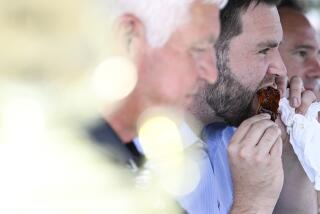Book review: First lady’s ‘American Grown’ tells of garden, mission
- Share via
American Grown
The Story of the White House Kitchen Garden and Gardens Across America
Michelle Obama
Crown: 272 pp., $30
Michelle Obama can recall a time when she “had no idea that tomatoes didn’t come in green plastic trays, covered by cellophane and that they could be any color other than pale red.”
She’s come a long way, and now she is working to bring the rest of us with her. Her efforts to garden on the White House lawn and to involve people all over the country in growing food are the subject of her first book, “American Grown.” (All author proceeds go to the National Park Foundation.)
Full of pictures of gorgeous gardens and produce, “American Grown” tells the story of the White House kitchen garden. There are recipes, advice on gardening and stories of successful community gardens from around the country — as well as a little history about growing food at the White House.
Ground was broken for the current garden on March 20, 2009, and it has become popular with staff volunteers, school groups and tourists. Even White House events have changed: “Since we planted the garden, I’ve noticed a change in what we cook,” observes Cris Comerford, the White House executive chef. “No longer are the meals we serve driven by the protein on the plate and garnished with a few baby carrots or other accent vegetables. Vegetables are now equal partners.”
About a third of the harvest is donated to Miriam’s Kitchen, which provides meals for homeless people.
“American Grown” has many warm and fuzzy moments, both in photos — Obama holding just-picked tomatoes, elementary school children and first dog Bo among the plants — and in words. Gardens, the first lady points out, are good at “reminding us of all we have in common and helping us grow stronger, more connected communities.”
Obama also addresses some serious questions about the American diet, noting that “millions of American families are living in so-called food deserts, communities without a single grocery store and no convenient access to fresh, nutritious food.”
Obesity-related health problems, she writes, cost $150 billion a year. And she offers startling details about the effect of diet on the military, from an interview with Lt. Gen. Mark Hertling: Not only can about half the recruits not pass a basic fitness test, but more than 62% of new recruits needs dental care before they can deploy and many have bone density issues that make them prone to fractures.
Those problems are the result of a decades-long change in how we eat and exercise, Obama notes, acknowledging that she too struggled over decisions about buying the right foods when she shopped for her family. In her book, as elsewhere, her great charm is her ability to seem like the rest of us.
She recalls a conversation with the Obamas’ pediatrician and a decision to improve the family’s eating habits. “We started small, emptying our pantry of unhealthy foods and filling our glasses with water and skim milk instead of sugary drinks,” she writes. “We ate at home more often. We began to add more vegetables to our meals.”
The problems Obama saw as first lady “alarmed” her and led to the “Let’s Move” program and her campaign against childhood obesity. “Rarely in the history of this country have we encountered a problem of such magnitude and consequence that is so eminently solvable,” she declares.
Her garden — the White House garden — is part of the solution: “I hoped this garden would help begin a conversation about the food we eat, the lives we lead, and how all of that affects our children.”







